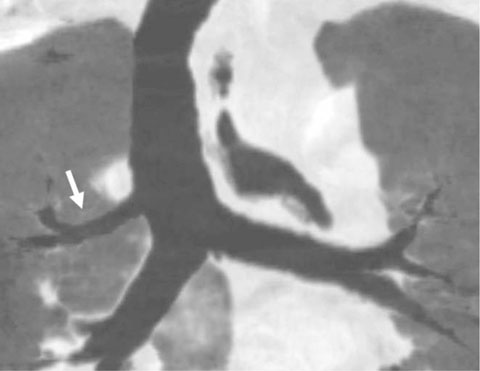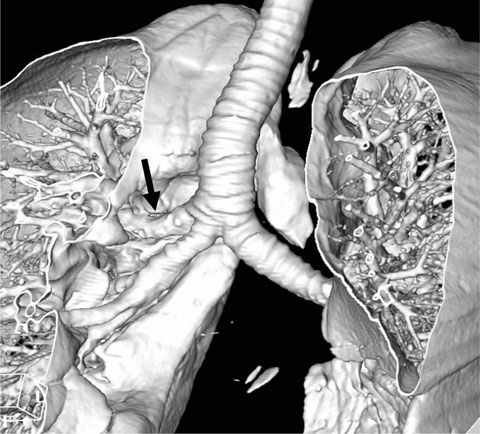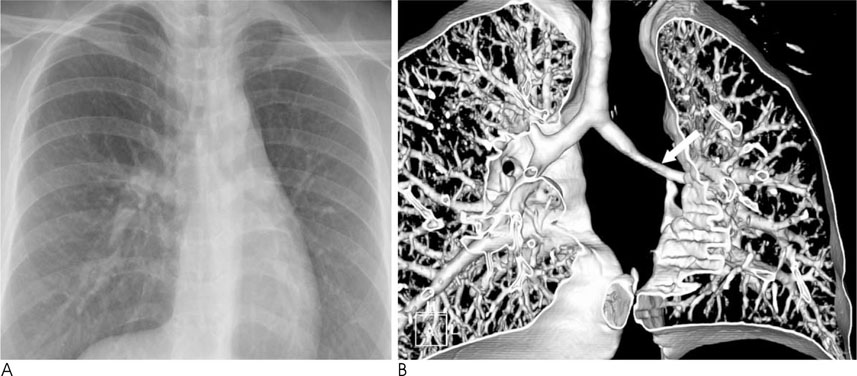J Korean Soc Radiol.
2010 Aug;63(2):149-159.
Tracheobronchial Branching Anomalies
- Affiliations
-
- 1Department of Radiology, Soonchunhyang University Cheonan Hospital, Korea. ytokim@schca.ac.kr
- 2Department of Family Medicine, Soonchunhyang University Hospital, Korea.
Abstract
- There are various congenital anomalies with respect to the number, length, diameter, and location of tracheobronchial branching patterns. The tracheobronchial anomalies are classified into two groups. The first one, anomalies of division, includes tracheal bronchus, cardiac bronchus, tracheal diverticulum, pulmonary isomerism, and minor variations. The second one, dysmorphic lung, includes lung agenesis-hypoplasia complex and lobar agenesis-aplasia complex.
MeSH Terms
Figure
Reference
-
1. Yedururi S, Guillerman RP, Chung T, Braverman RM, Dishop MK, Giannoni CM, et al. Multimodality imaging of tracheobronchial disorders in children. Radiographics. 2008; 28:E29.2. Ghaye B, Szapiro D, Fanchamps JM, Dondelinger RF. Congenital bronchial abnormalities revisited. Radiographics. 2001; 21:105–119.3. Beigelman C, Howarth NR, Chartrand-Lefebvre C, Grenier P. Congenital anomalies of tracheobronchial branching patterns: spiral CT aspects in adults. Eur Radiol. 1998; 8:79–85.4. Zylak CJ, Eyler WR, Spizarny DL, Stone CH. Developmental lung anomalies in the adult: radiologic-pathologic correlation. Radiographics. 2002; S25–S43.5. Goo JM, Im JG, Ahn JM, Moon WK, Chung JW, Park JH, Seo JB, Han MC. Right paratracheal air cysts in the thoracic inlet: clinical and radiologic significance. AJR Am J Roentgenol. 1999; 173:65–70.6. Soto-Hurtado EJ, Peñuela-Ruíz L, Rivera-Sánchez I, Torres-Jiménez J. Tracheal diverticulum: a review of the literature. Lung. 2006; 184:303–307.7. Applegate KE, Goske MJ, Pierce G, Murphy D. Situs revisited: imaging of the heterotaxy syndrome. Radiographics. 1999; 19:837–852.8. Mata JM, Cáceres J. The dysmorphic lung: imaging findings. Eur Radiol. 1996; 6:403–414.9. Godwin JD, Tarver RD. Scimitar syndrome: four new cases examined with CT. Radiology. 1986; 159:15–20.10. Frank JL, Poole CA, Rosas G. Horseshoe lung: clinical, pathologic, and radiologic features and a new plain film finding. AJR Am J Roentgenol. 1986; 146:217–226.
- Full Text Links
- Actions
-
Cited
- CITED
-
- Close
- Share
- Similar articles
-
- A Case of Pulmonary Artery Sling Associated with Tracheobroncheal Hypoplasia
- Ruptured proximal anterior cerebral artery (A1) aneurysm located at an anomalous branching of the fronto-orbital artery--a case report
- Effect of Anesthetics on Protein Content of Alveolar Washings of Rabbits
- Esophageal stenosis due to tracheobronchial remnants: a case report
- Usefulness of intraoperative bronchoscopy during surgical repair of a congenital cardiac anomaly with possible airway obstruction: three cases report




















